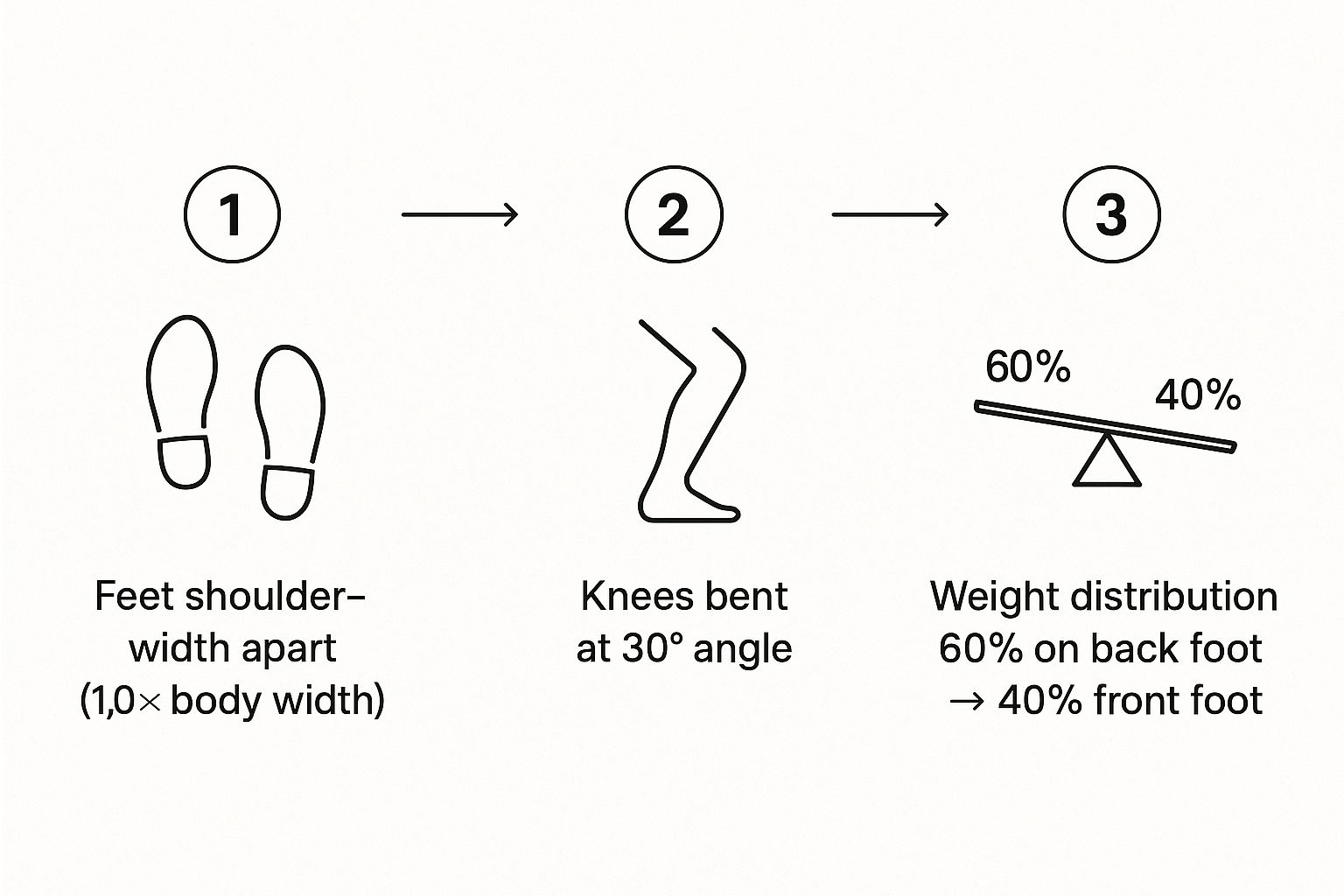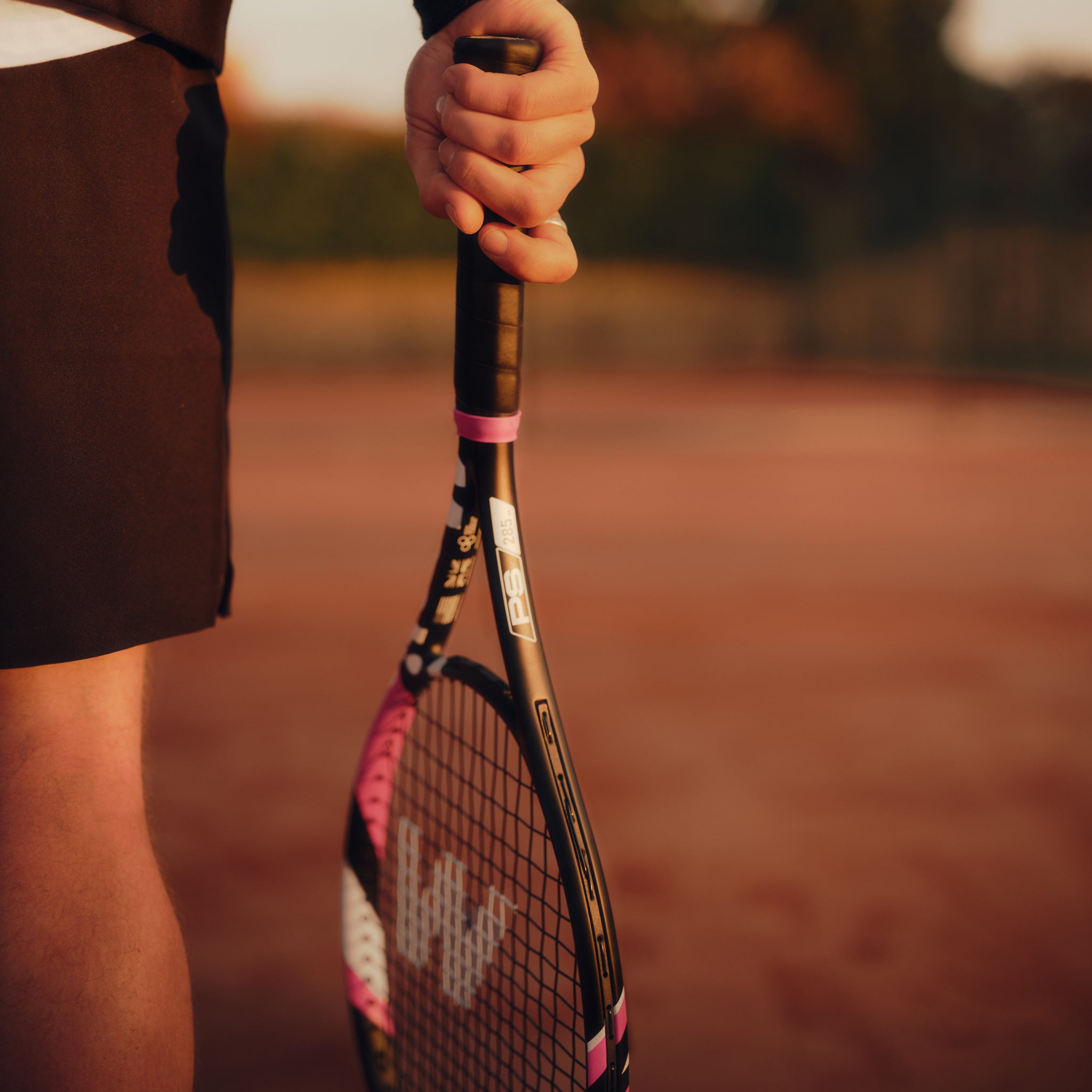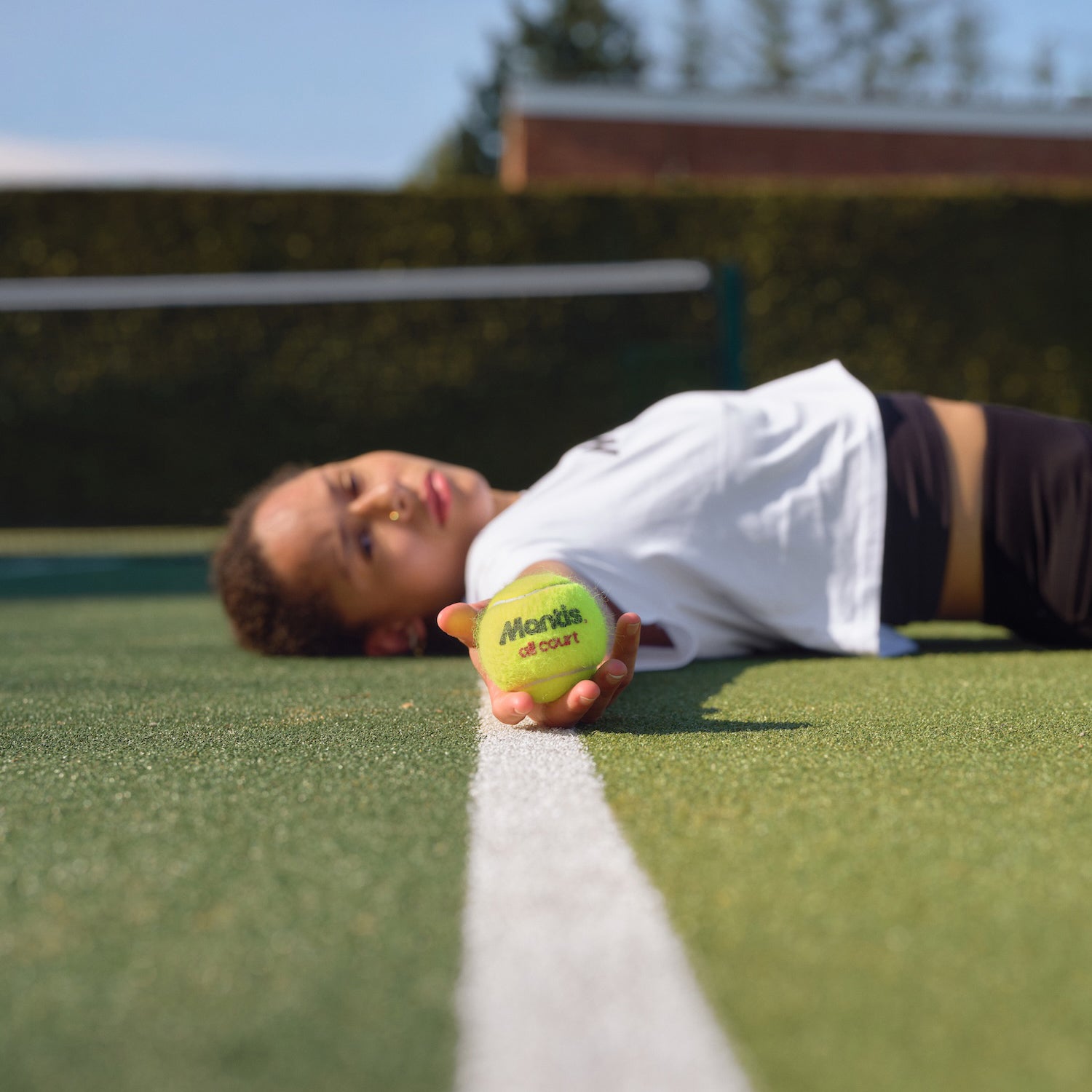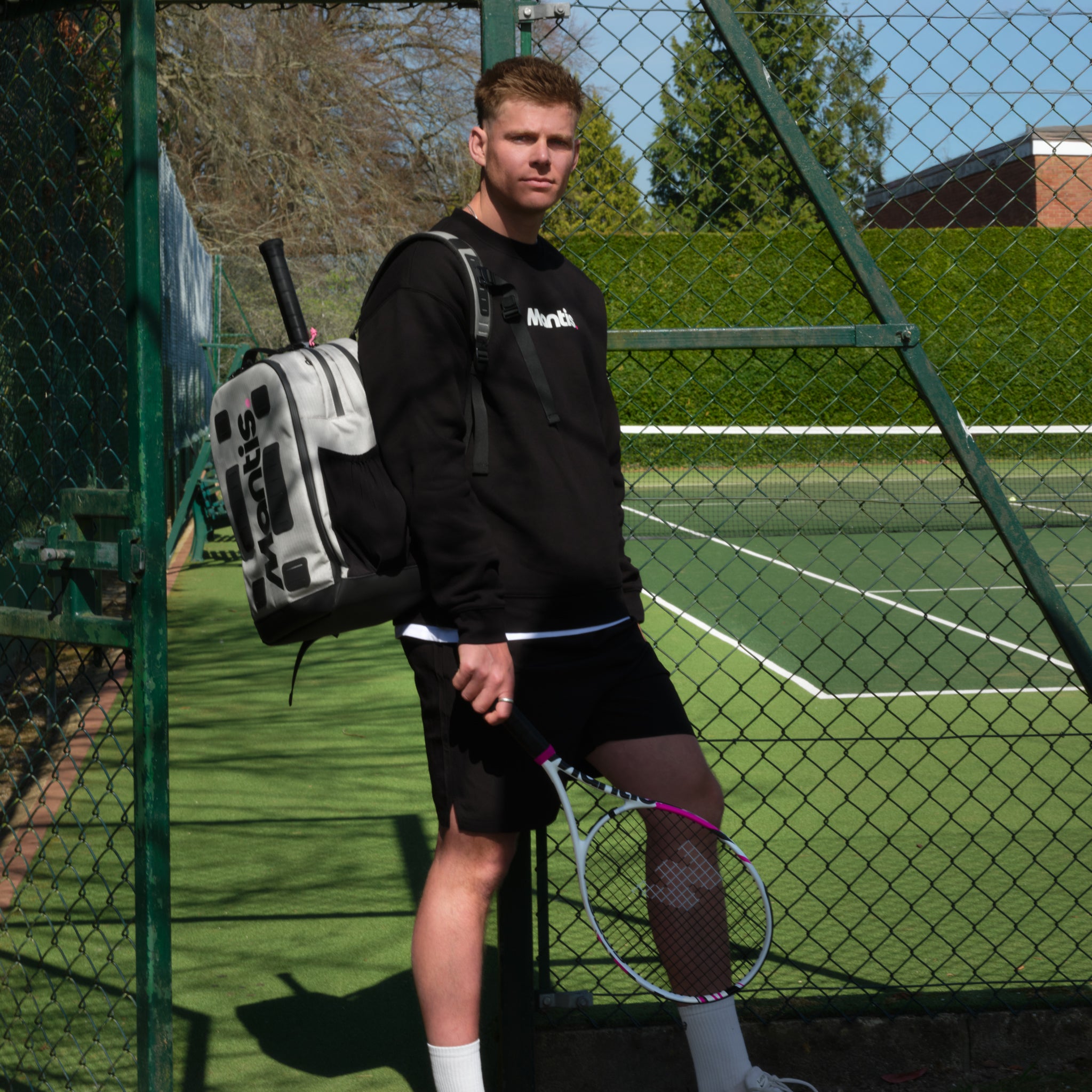
The secret to a dominant forehand technique isn't the swing itself, but what happens in the moments just before you hit the ball. Get the grip and stance right, and you've laid the groundwork for power, control, and spin. These fundamentals are where a reliable, potent shot is born.
Building Your Forehand Technique From the Ground Up
Before you even think about hitting winners, your body needs to be in position and the racket needs to feel like an extension of your hand. Your grip and stance are the two pillars that support a fluid, athletic swing. Nail these, and everything else becomes easier and far more effective. A great forehand starts with a strong foundation.
Of course, having the technical know-how is one thing, but being able to repeat it throughout a long match is another. That's where physical endurance comes in, as learning how to improve stamina will let you practise for longer and maintain your form when it matters most.
Choosing the Right Forehand Grip
Your grip is your only connection to the racket, so it directly influences the racket face angle at impact. For the modern forehand, the conversation really revolves around two main choices: the Eastern and Semi-Western grips. Each has its own personality and suits a different style of play.
The Eastern grip is often called the "handshake grip" for a reason—it feels natural. It’s a fantastic choice for players who like to hit flatter, driving shots and move forward to the net, as it makes switching to a volley grip incredibly simple. Think of it as a solid, all-purpose grip for hitting through the ball with authority.
On the other hand, if you're a baseliner looking to control points with heavy topspin, the Semi-Western grip is your best friend. It’s probably the most popular grip you’ll see on the tour today. It naturally closes the racket face, making it much easier to brush up the back of the ball and generate the kind of spin that pulls your opponent off the court.
If you want to really dive into the nuts and bolts of holding the racket, this guide on how to grip a tennis racket is an excellent resource.
Key Takeaway: Don't just copy your favourite pro. Choose a grip that matches the shot you want to hit. Whether you’re aiming for aggressive, flat drives or heavy, consistent topspin, your grip is the first decision you make.
The Importance of a Dynamic Stance
Your stance—how you set your feet—is all about balance, rotation, and recovery. The right stance gives you a stable platform to swing from and gets you ready for the next shot. There are three main forehand stances, and knowing when to use each is a game-changer.
-
Closed Stance: This is the classic setup. You turn your body completely sideways to the net, stepping across with your front foot. It offers maximum stability and a full, powerful turn of the hips and shoulders. It's perfect when you have plenty of time and want to really unload on a ball.
-
Neutral Stance: A bit more versatile, here your feet are roughly parallel to the sideline. This is a great middle-ground, offering a solid mix of balance and mobility for most rally situations.
-
Open Stance: The cornerstone of the modern game. Instead of turning sideways, you face the net more directly, loading your power into your outside leg. It's the go-to stance for hitting wide balls or when you're rushed for time. The explosive rotation from an open stance allows for a much quicker recovery back to the middle of the court.
Think of your stance as a reaction, not a preset position. A club player who only ever uses a closed stance will constantly be jammed by fast, deep shots. But a player who has mastered all three can adapt to anything the opponent throws at them, staying balanced and ready to hit their best forehand, no matter the situation.
Mastering the Modern Forehand Swing Mechanics
Right, you’ve got your grip sorted and your stance is solid. Now for the fun part. The swing is the engine of your forehand, the moment you convert all that preparation into raw, kinetic energy. A truly great forehand isn't just an arm movement; it's a fluid chain reaction. Power flows from the ground, up through your legs and core, and culminates in explosive racquet head speed.
Think of it like cracking a whip. The handle—your legs and body—initiates the motion, and that energy surges all the way to the tip, which is your racquet. If there's any hitch or break in that kinetic chain, you'll leak power and lose consistency. Let’s break down how to build this seamless, powerful motion.
The Crucial Unit Turn
The very first thing you do when you see a forehand coming is the unit turn. This isn't just a casual shoulder turn. It’s about rotating your hips and shoulders together as one solid unit. A great tip is to keep your non-hitting hand on the racquet's throat during this initial turn; it forces your upper body to move in perfect sync.
This simple action achieves several critical things instantly:
- It gets your body sideways to the ball, which is non-negotiable.
- It starts coiling your core muscles, loading them like a spring.
- It begins the backswing naturally, so you don't need a jerky, isolated arm pull.
Picture a coiled spring. The unit turn is the act of twisting that spring, getting it ready to uncoil with force right into the ball. A classic mistake I see all the time is players pulling the racquet back with just their arm, leaving their body facing the net. That disconnects the entire power chain from the get-go.
Building Energy with the Racquet Drop
As you finish your turn and start moving to intercept the ball, the next piece of the puzzle is the racquet drop. After the initial take-back, you want the racquet head to drop below the level of your hand, often creating a smooth "C" or loop shape in the air. This isn't just letting it fall; it's a controlled relaxation that creates lag and sets the stage for massive acceleration.
The racquet drop is where you build the potential for serious racquet head speed. By letting the racquet head fall below the wrist, you create a longer, more powerful arc to swing up and through the ball. It’s the dip before the explosion.
This image shows the fundamental ready position that is the foundation for the unit turn and everything that follows. Notice the athletic posture, bent knees, and balanced weight distribution.

This is your starting point. Without this proper athletic base, generating an effective forehand swing becomes ten times harder.
The Windshield Wiper Finish
The forward swing and follow-through are where the modern forehand really shows its colours. As you uncoil your body—hips first, then your torso, then the shoulder—the racquet accelerates towards the contact point, which should always be well out in front of you.
The forehand technique has changed dramatically over the years, especially here in the UK. We used to see the classical forehand everywhere until the early 2000s, where players would finish high over their shoulder. But modern racquet technology changed everything. Today, UK players, like the pros they watch, have overwhelmingly adopted the windshield wiper forehand. This technique, with its distinctive finish across the body, allows players to generate huge amounts of topspin to control the power of the modern game. For a deeper dive into this, check out the Wikipedia page on the evolution of forehand styles.
The table below breaks down some of the key technical differences between these two styles.
Classical vs Modern Forehand Characteristics
| Characteristic | Classical Forehand | Modern (Windshield Wiper) Forehand |
|---|---|---|
| Grip | Typically Eastern or Continental. | Semi-Western or Western. |
| Stance | Often a closed or neutral stance. | Open or semi-open stance is common. |
| Contact Point | Closer to the body, around waist level. | Further out in front, often higher. |
| Swing Path | Flatter, more linear path through the ball. | Low-to-high, C-shaped swing path. |
| Follow-through | High, over the hitting shoulder. | Across the body, near the opposite shoulder. |
| Primary Goal | Drive, pace, and placement. | Heavy topspin, high margin for error, and power. |
This "windshield wiper" motion refers to how the racquet moves up and across the ball. After making contact, your wrist and forearm rotate, and the racquet finishes across the opposite side of your body, often ending up near your opposite shoulder or bicep.
This finish isn't just for style points. It's the biomechanical secret to creating massive topspin. By brushing up the back of the ball so aggressively, you hit a high, heavy shot that dives sharply into the court. This gives you a huge margin for error while still letting you hit with serious pace. It's exactly how today's players manage to be both aggressive and incredibly consistent.
Where Does Real Forehand Power Come From?
So many club players get stuck in a rut, thinking a monster forehand is all about muscling the ball with a huge arm swing. While your arm is obviously involved, the true engine for that blistering racket-head speed is your body's core and the way it rotates. It’s one of the biggest myths in tennis: power doesn't come from the shoulder out; it’s generated from the ground up.
Think of your hips and trunk as the real powerhouse. When you start your swing with an explosive uncoiling of your core, you set off a kinetic chain. This chain reaction multiplies force, sending it up through your shoulder, down your arm, and right into the racket head. A swing that just uses the arm isn't only weaker, but it also puts a ton of strain on your shoulder and elbow, which is a fast track to inconsistency and injury.
Unlocking Your Rotational Engine
To generate serious pace, you have to learn how to separate the movement of your upper and lower body. It all begins with the unit turn—coiling your hips and shoulders together away from the ball. The explosive part happens when you uncoil: your hips should fire first, driving toward the net, with your torso and shoulders following a fraction of a second later.
This slight delay, what coaches call "separation," creates a stretch-shortening cycle in your core muscles. It’s like stretching a rubber band to its limit right before you let it snap. This is where most amateurs lose power. They rotate their hips and shoulders at the same time, which feels strong but actually leaks a massive amount of potential energy. Focus on letting your hips lead the charge.
Expert Insight: The feeling you're after is that your arm and racket are just coming along for the ride, whipped through the contact zone by the force of your body's rotation. A relaxed arm is crucial for letting all that power transfer smoothly into the ball.
Picture a professional boxer. They don't just throw a punch with their arm; the power starts from their feet and drives up through their hips and core. Your forehand works exactly the same way. Getting this concept right is what turns a decent shot into a truly devastating weapon.
The Science Behind Speed and Spin
It’s not just about turning; it’s about the speed and timing of that turn. Thanks to biomechanical analysis from sports science departments here in the UK, we have a much clearer picture of where this power truly originates. Research has shown that humeral internal rotation—the lightning-fast rotation of your upper arm—is responsible for over 40% of the final ball speed.
One UK-based study found that as players ramped up their effort from moderate to maximum, the internal rotation speed of the upper arm almost doubled, jumping from 477 degrees per second to a staggering 1128 degrees per second. At the same time, trunk rotation speed shot up by 91%, proving just how vital it is for these two movements to work in sync. If you're a data geek, you can find more on these kinematic findings in the full research paper.
What this data really confirms is that the best forehands are a combination of a violent trunk rotation and an equally rapid internal rotation of the arm, all happening at the moment of impact.
Practical Drills for Building Power
Developing this rotational strength takes work, both on and off the court. Here are a few practical drills to help you build a more powerful forehand from the ground up.
- Medicine Ball Throws: Stand sideways to a solid wall, holding a medicine ball. Go through your forehand motion, focusing on rotating your hips and core explosively to throw the ball against the wall. This drill is a direct way to train the correct power sequence.
- Shadow Swings with Resistance: Anchor a resistance band to the court fence. Perform slow, deliberate shadow swings, really concentrating on feeling the stretch across your core as you lead the rotation with your hips, followed by your shoulders.
- "Feet Together" Drill: On the court, start with your feet together before you hit a forehand. As the ball comes, step into the shot. This forces you to initiate the movement with your lower body and ensures your weight is moving forward, adding linear momentum to your rotational power.
Making these exercises a regular part of your routine will build the muscle memory and strength you need. While technique is everything, don't forget your equipment. If you feel like you've maxed out your power gains, it might be time to check out our guide on how to choose a tennis racket to make sure your frame is helping, not hurting, your game.
Pushing your body to unlock this explosive power is demanding. After these intense training sessions, using effective post-workout massage tips can make a real difference in speeding up your recovery, so you’re ready to go for your next hit.
Winning the Point Before You Hit the Ball
A textbook swing is worthless if you arrive at the ball late and off-balance. I've seen it a thousand times: players with beautiful strokes who are constantly scrambling. The real secret to a consistent, powerful forehand lies in your feet.
Excellent footwork is the unsung hero of the tennis forehand, often winning you the point long before your racquet even makes contact. It’s what puts you in the perfect position to unleash a full, fluid swing every single time.
This whole process starts not with a big sprint, but with a small, crucial hop. The split-step is your trigger move. As your opponent makes contact with the ball, you should perform a small jump, landing on the balls of your feet with a wide, stable base.
This single action primes your body to explode in any direction. It turns you from a static observer into a dynamic athlete ready to react. Without it, you’re always playing catch-up.
Fine-Tuning Your Position with Adjustment Steps
Once you’ve made your initial move towards the ball, the job isn’t done. The difference between a good shot and a great one often comes down to the final few centimetres of spacing. This is where small, quick adjustment steps come into play.
Think of them as tiny shuffles that allow you to dial in your distance from the ball, ensuring you’re not too cramped or over-reaching. It’s like focusing a camera lens: your first big move gets you into the general area, but these little steps bring the ball into perfect focus. They ensure your contact point is consistently out in front, giving you the space for a full rotation and a clean hit.
A Coach's Tip: So many players stop moving their feet just before they swing. This is a critical error. The best players I've worked with keep their feet active right up until the moment of contact, making those tiny adjustments that create perfect spacing.
Handling Different Court Scenarios
Efficient movement isn't a one-size-fits-all approach. Your footwork has to adapt to what's coming over the net. Mastering these patterns turns your movement from a simple necessity into a tactical weapon.
-
Attacking the Short Ball: When you see a short ball, your first move should be explosive and forward. Use longer, driving strides to cover ground, but as you get closer, shift to smaller steps to adjust. This stops you from running over the ball and lets you get set for an aggressive, attacking shot.
-
Defending a Deep Ball: When you're pushed deep, your goal is to create space. I teach players to use crossover steps to move back and sideways, pushing off their inside leg. This helps you keep your balance while retreating, buying you the time needed to set up for a neutral or defensive reply.
-
Dealing with a Ball at Your Body: This is where great footwork really shines. A ball hit right at you kills your space to swing. The key is to move your feet away from the ball, not just lean your body. Quick shuffle steps or a sharp pivot can create the room you need for your unit turn and swing path, turning a difficult jam-shot into a manageable forehand.
By building an instinct for these movement patterns, you ensure you always arrive on time and in balance. This foundational skill is what allows every other part of your forehand—the unit turn, the racquet drop, and the follow-through—to function at its peak. Without it, you’re just hoping for the best.
Fixing Common Forehand Flaws and Faults
Every player, from weekend warriors to seasoned competitors, develops bad habits. It’s just part of the game. This section is your troubleshooting guide for ironing out the most common kinks that creep into your forehand, turning a reliable shot into a truly fearsome one.
The real difference between a good player and a great one isn't brute strength; it's efficiency. The pros make it look easy because their timing and kinetic chain are perfectly in sync, generating massive racquet speed with what looks like minimal effort.
This isn’t just feel-good advice; the data backs it up. Research into player skill levels has shown that forehand technique is a massive differentiator. In fact, studies show that experts have much higher racquet head velocities and that biomechanical analysis alone can distinguish skill levels with over 90% accuracy. They have better posture and faster angular movements in their shoulders and wrists. You can dig into the specifics of these biomechanical findings at Loughborough University's repository.
That efficiency isn't magic. It's a skill you can learn. Let’s break down the common errors that rob you of power and control, and more importantly, how to fix them.
Diagnosing the Problem: Hitting into the Net
There’s nothing more frustrating than dumping a forehand into the net. You do all the hard work to set up the point, only to see it die at the tape. This problem almost always comes down to two culprits: your swing path or your contact point.
First, check your swing. A flat or downward swing path is a guaranteed way to send the ball low. The fix is to consciously ingrain a low-to-high motion. A great mental trick is to feel your racquet head drop below the height of the ball just before you start your forward swing. From that low point, swing up and through the ball, finishing high over your opposite shoulder.
If your swing path feels good, the next thing to look at is your contact point. Hitting the ball late (when it's level with or even slightly behind your body) causes the racquet face to close down on impact. You have to make contact well out in front. Try this simple drill: place a cone a foot or two ahead of you on the court and make it your mission to hit the ball before your racquet reaches the cone.
Why Your Forehand Keeps Flying Long
On the flip side, we have the forehand that sails metres past the baseline. When you’re hitting long, it's a control issue, not a power issue. The root cause is almost always an open racquet face at impact.
This can happen for a few reasons:
- Your grip is too "open": A Continental or a very conservative Eastern grip makes it tough to naturally roll the racquet over the ball for topspin.
- Your wrist is unstable: A lot of players try to add extra "pop" by flicking their wrist open at the last second. This just sends the ball flying.
- You're leaning back: If you're fading away from the shot as you hit, your body weight shifts backwards, which opens up your shoulders and, by extension, your racquet face.
Key Takeaway: To fix a long forehand, the answer isn't to hit softer—it's to hit with more spin. Slowing down your swing will only make the problem worse. Instead, focus on aggressively brushing up the back of the ball. The 'windshield wiper' follow-through was practically invented to solve this exact problem.
Fixing Off-Centre Hits and Framed Shots
Shanking the ball or hitting it off-centre feels awful. You get zero power, zero control, and that horrible "thud" sound. The number one cause is surprisingly simple: you took your eye off the ball. It’s a classic mistake that even the pros make under pressure.
You need to train yourself to keep your head still and watch the ball all the way onto your strings. A fantastic drill for this is to try and see the seams of the ball as you hit it. You won't actually be able to, but the act of trying forces you to maintain intense focus and stops your head from pulling up too early.
Poor spacing is another common reason for framing shots. Get too close to the ball, and you'll have no room for a fluid swing, leading to a cramped, jerky motion. Remember those small adjustment steps we talked about earlier? They are absolutely crucial for maintaining the perfect distance from the ball so you can find the sweet spot time and time again.
Common Forehand Questions Answered
Even when you’ve got the theory down, some questions about the forehand just keep popping up. It's totally normal. Every player runs into specific hurdles that feel like they're unique to their game, and this is where we tackle them head-on.
Think of this as your quick-fire troubleshooting guide. Whether you're just finding your rhythm or you're an intermediate player looking to add some polish, these are the fixes for those nagging issues that can really stall your progress.
Which Forehand Grip Is Best For Beginners?
For most players just starting, the Eastern grip is the simplest and most natural way in. It’s often called the "handshake grip" for a reason—it just feels right. This grip lets you hit a fairly flat ball with decent power without needing a lot of tricky wrist work, which is brilliant for building confidence early on.
That said, the Semi-Western grip is probably the better long-term investment. It's the most common grip you'll see in modern tennis for a good reason. It naturally encourages a slightly closed racquet face, which helps you generate topspin almost without thinking. Starting with a Semi-Western grip builds a foundation you can grow with as you develop a more advanced, spin-heavy game.
Our advice? Steer clear of the full Western grip when you're starting out. It demands a very specific and physically tough swing that's incredibly difficult to get right without one-on-one coaching. It often just leads to timing problems and a lot of frustration.
How Do I Stop Hitting My Forehand Into The Net?
Ah, the net forehand. A frustratingly common issue, but it almost always comes down to one of three things. Figuring out which one is your culprit is the first step.
First, look at your swing path. A lot of players who find the net are swinging too flat, or worse, with a high-to-low motion. Your swing absolutely must travel low-to-high. Make a conscious effort to drop the racquet head below the ball before you swing forward. Really feel like you're brushing up the back of the ball and finishing high over your opposite shoulder.
Next up, check your contact point. If you’re hitting the ball late—level with or even behind your body—your racquet face will naturally close at impact. You’ve got to make contact out in front of your body. A great mental cue is to imagine a line about a foot in front of your lead foot and force yourself to strike the ball before your racquet ever crosses it.
Lastly, don't rule out your gear. If your technique feels okay, your strings might be the problem. Overly high string tension or strings that have gone "dead" will rob your shots of power and cause the ball to drop short.
Why Is My Forehand Going Long So Often?
Sailing the ball long isn’t a power problem; it’s a control problem. The number one cause is an open racquet face at the moment you strike the ball. This launches it on a high, flat trajectory with no spin to help gravity pull it back down into the court.
This open face is often the result of an unsuitable grip, like trying to hit a modern topspin shot with an old-school Continental grip. It can also be a technical flaw where your wrist gets too loose and flicks open right at impact—usually a misguided attempt to slap more power onto the ball that ends up backfiring.
The fix isn't to swing slower; in fact, that can make it even worse. The solution is to generate more topspin.
Here’s how you can do that:
- Focus on the brush: Really exaggerate the feeling of brushing up the back of the ball. It’s a lift, not a push.
- Embrace the windshield wiper: The modern follow-through across the body is specifically designed to create the racquet head rotation needed for heavy spin.
- Stay balanced: Make sure you aren't leaning back as you hit. Your weight should be moving forward, into the court, helping you dictate the ball's flight path.
At Mantis, we understand that real progress comes from mastering the details. Your forehand is a reflection of your dedication, and your equipment should honour that commitment. We design racquets, balls, and gear with a single purpose: to provide the precision and feel that serious players demand. Discover equipment built for performance, not hype, at https://mantissport.com.








